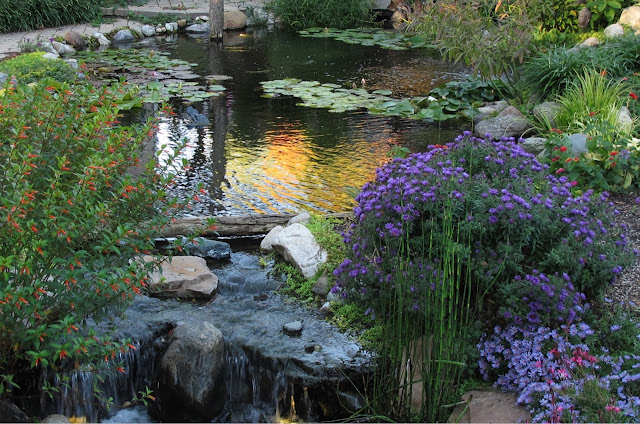How to Properly Check the Water Level in Your Pond.
 |
| You may be surprised to learn there's a correct and incorrect way to measure your water level. |
You hear your pump sucking for air. Is it a leak? Or just normal evaporation? How can you tell? You need to check the water level in your pond.
Water loss in a water feature can be somewhat confusing. Hopefully this will help clear the air on how to check your water feature's exact water level. This information will be referencing a water feature with a skimmer. The skimmer is the plastic box that holds filter media and your pump.
We recommend using the inside of the skimmer to help determine your pond's exact water level.
 |
| With very little exception, ponds with skimmers should have an overflow opening in the back. The overflow sets the water level. |
The over flow pipe in a skimmer is usually located in the back of the skimmer box just above the pump. It will have an opening usually approximately two inches in diameter. That is the opening in which excess water, like rain water, will be drained from your pond. This makes for a fantastic reference point.
Now here is where it becomes a little more tricky. When checking the water level in your pond from this point of reference keep in mind that the filters will need to be clean. A clogged skimmer net, filter pad or brushes can impede water from making it to the pump. Often times when a pump in a skimmer is making noise from a lack of water it simply needs the filters clean. Leaves, algae, trash can all block the water flow making it difficult for water to reach the pump behind all of the filters. That is what these filters are supposed to do, keep debris out of your pump. They are in place to filter debris from the pond and keep your pump clear.
So when checking your feature's water level, make sure to use a reference point in the skimmer with clean filters. Give your skimmer basket / net and brushes / filter mat a rinse before measuring your water level.
If you feel you have a leak, check your feature daily and record your findings. A leak is constant and consistent. There are many factors to consider in determining water loss, wind, relative humidity, size of the waterfalls compared to the pond surface, even terrestrial plants and aquatic plants have a huge effect on evaporation and water usage. We had a tree next to one of our ponds that found a way to send a root into a biofalls of the pond. The root took off inside the water fall and the tree "drank" about two inches a day. Once we cut the root off there was no more adding water daily to the pond.
Another factor to consider is ground water. We have seen cases where a customer has had a substantial water loss almost over night, Then when they fill the pond back up there is no water loss for days or weeks, then suddenly it happens again, tremendous water loss over night. What we have found is that ground water under the liner can force the liner upward into the body of the pond water. When this happens it displaces the water in the pond forcing it out the overflow pipe. Then once the ground water seeps back into the soil, the liner lays down, the pond level drops and it leaves the appearance of a large water loss. Some tell tale signs of ground water under the liner are the liner is ballooned up in the pond, gravel and sometimes even boulders are displaced from the bottom and sides of the pond or a substantial water loss all at once, then no water loss at all. The remedy for that situation will depend on the specific location of the water feature.
If you think you're losing more water than normal, understand that certain weather conditions and lots of aquatic plants can cause a lot of water loss! During a hot summer, we top off our ponds twice a week. You can get more info on what water loss is normal here.
So to summarize on how to check your water level:




Comments